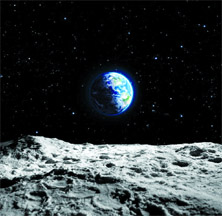
Chinese scientists studying the soil samples of the moon brought by Chang’e-5 mission found water molecules in lunar soil, according to the Chinese Academy of Sciences (CAS).
The research, carried out jointly by researchers from the Beijing National Laboratory for Condensed Matter Physics and the Institute of Physics of CAS and other domestic research institutions, was published in the peer-reviewed journal Nature Astronomy on July 16, the Hong Kong-based South China Morning Post reported.
Based on lunar soil samples returned by Chang’e-5 mission in 2020, Chinese scientists have found a hydrated mineral “enriched” with molecular water, CAS said.
In 2009, India’s Chandrayaan-1 spacecraft detected signs of hydrated minerals in the form of oxygen and hydrogen molecules in sunlit areas of the moon.
Among its suite of instruments, it carried NASA’s Moon Mineralogy Mapper (M3), an imaging spectrometer that helped confirm the discovery of water locked in minerals on the Moon.
In 2020, NASA announced the discovery of water on the sunlit surface of the moon based on data from the airborne Stratospheric Observatory for Infrared Astronomy, which detected water molecules in the Clavius crater, one of the largest craters visible from Earth, in the moon’s southern hemisphere.
But the lack of returned lunar samples from high latitude and polar regions means that “neither the origin nor the actual chemical form of lunar hydrogen has been determined”, according to the Nature article.
The Chinese scientists studying the lunar soil isolated more than 1,000 mineral “clasts”. The researchers said that among them was a platelike transparent crystal, dubbed “unknown lunar mineral” (ULM-1), that contained water molecules, the Post reported.
The researchers ruled out the possibility that the water-bearing mineral was contaminated by terrestrial sources or rocket exhaust.
But one geochemist said he expected the team to find more evidence in their further study. “If this water-bearing mineral is present in the lunar samples, more than one piece should be found,” said the scientist who asked not to be named and was not associated with the study. Source: PTI




Be the first to comment